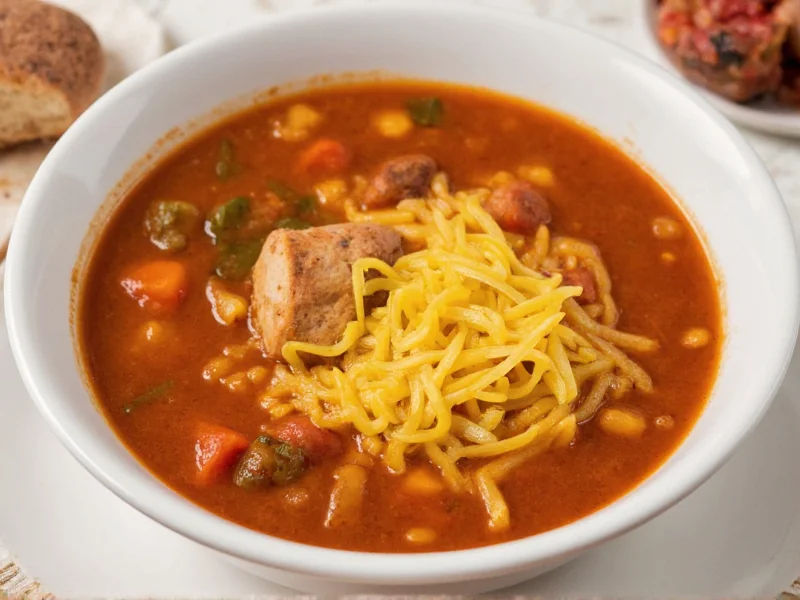Nothing beats a steaming bowl of homemade tortilla soup on a chilly evening. This traditional Mexican-inspired recipe transforms pantry staples into a restaurant-quality meal that impresses with minimal effort. The secret lies in layering flavors through proper technique rather than complicated ingredients.
Essential Ingredients for Perfect Tortilla Soup
Quality ingredients make the difference between ordinary and extraordinary tortilla soup. While authentic recipes vary by region, these core components create that distinctive flavor profile everyone loves.
| Ingredient | Amount | Key Purpose |
|---|---|---|
| Fire-roasted diced tomatoes | 28 oz | Provides depth and smoky base flavor |
| Chicken broth | 4 cups | Creates rich foundation (use vegetable broth for vegetarian version) |
| White corn | 1 cup | Adds sweetness and texture contrast |
| Chipotle peppers in adobo | 1-2 peppers + 1 tbsp sauce | Delivers signature smoky heat |
| Fresh lime juice | 2 tbsp | Brightens flavors and balances richness |
Step-by-Step Preparation Guide
Follow these professional kitchen techniques to elevate your homemade tortilla soup from good to exceptional.
- Sauté aromatics: Heat 2 tbsp olive oil in a large pot over medium heat. Add 1 diced white onion and 4 minced garlic cloves. Cook until translucent (5-7 minutes) without browning.
- Build flavor base: Stir in 1 tbsp ground cumin, 1 tsp smoked paprika, and 1/2 tsp oregano. Cook for 1 minute until fragrant, stirring constantly to prevent burning.
- Add tomatoes and peppers: Pour in fire-roasted tomatoes (with juices) and chipotle peppers. Simmer for 10 minutes to deepen flavors.
- Combine liquids: Add chicken broth and corn. Bring to a gentle boil, then reduce heat and simmer uncovered for 20 minutes.
- Final seasoning: Stir in fresh lime juice and salt to taste. For authentic restaurant-style texture, remove 1 cup of soup, blend until smooth, then return to pot.
Serving Tradition and Presentation
Traditional tortilla soup presentation enhances both flavor and visual appeal. The contrast between hot soup and cool toppings creates a dynamic eating experience.
Place crispy tortilla strips in the bottom of each bowl before pouring hot soup over them. This technique keeps the strips partially crisp while allowing some to soften in the broth. Top with:
- Fresh avocado cubes
- Cilantro leaves
- Crumbled queso fresco or cotija cheese
- Lime wedges for additional acidity
- Sliced radishes for crunch
Storage and Reheating Instructions
Proper storage maintains quality when making ahead or enjoying leftovers. Tortilla soup actually improves in flavor after ingredients meld overnight.
Store components separately for best results: keep tortilla strips in an airtight container at room temperature, and refrigerate the soup base. When reheating, warm the soup gently over medium-low heat without boiling to preserve flavor integrity. Add fresh toppings just before serving.
Variations for Different Dietary Preferences
This versatile recipe adapts beautifully to various dietary needs while maintaining authentic flavor characteristics.
Vegetarian tortilla soup: Substitute vegetable broth and omit chicken. Add 1 cup black beans for protein. For umami depth, include 1/2 tsp mushroom powder.
Chicken tortilla soup: Add 2 cups shredded cooked chicken during the last 5 minutes of simmering. Poach bone-in chicken thighs in the broth for richer flavor before shredding.
Spice adjustments: For mild version, omit chipotle peppers and use 1/4 tsp cayenne. For extra heat, add 1 minced jalapeño with the onions.
Common Mistakes to Avoid
Even experienced home cooks make these preventable errors when preparing traditional tortilla soup recipe:
- Overcooking tortilla strips: Adding them too early makes them soggy. Always place strips in bowls first, then pour hot soup over them.
- Skipping the bloom step: Toasting spices in oil before adding liquids unlocks their full flavor potential.
- Using regular tomatoes: Fire-roasted tomatoes provide essential smoky notes that regular diced tomatoes can't match.
- Over-blending: Blending the entire soup creates an undesirable puree texture. Only blend a portion for ideal consistency.
Frequently Asked Questions
Can I make tortilla soup without chicken broth?
Yes, vegetable broth works perfectly for vegetarian tortilla soup. For best flavor, use a mushroom-based vegetable broth or add 1 tsp nutritional yeast to regular vegetable broth for umami depth.
How do I keep tortilla strips crispy in soup?
Place homemade or store-bought tortilla strips in the bottom of each bowl before pouring hot soup over them. This technique keeps the bottom layer partially crisp while allowing some to soften in the broth for ideal texture contrast.
What's the difference between tortilla soup and pozole?
While both are traditional Mexican soups, tortilla soup features tomato-based broth with corn and crispy tortilla elements, while pozole uses hominy corn and comes in red, green, or white varieties with different broth bases. Tortilla soup typically includes more fresh garnishes served tableside.
Can I freeze homemade tortilla soup?
Yes, the soup base freezes well for up to 3 months. However, do not freeze with tortilla strips or fresh garnishes. Thaw overnight in refrigerator and reheat gently, adding fresh toppings when serving.
How can I make my tortilla soup thicker?
For thicker tortilla soup without altering flavor, remove 1-2 cups of soup, blend until smooth, then return to pot. Alternatively, create a slurry with 1 tbsp cornstarch mixed with 2 tbsp cold water, then stir into simmering soup.











 浙公网安备
33010002000092号
浙公网安备
33010002000092号 浙B2-20120091-4
浙B2-20120091-4